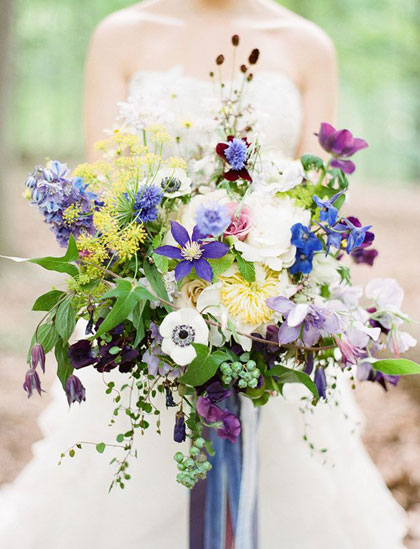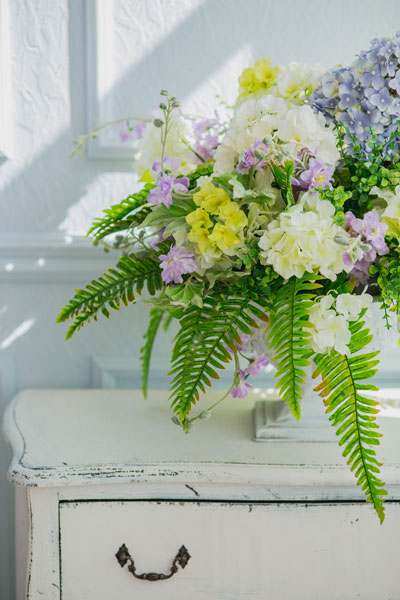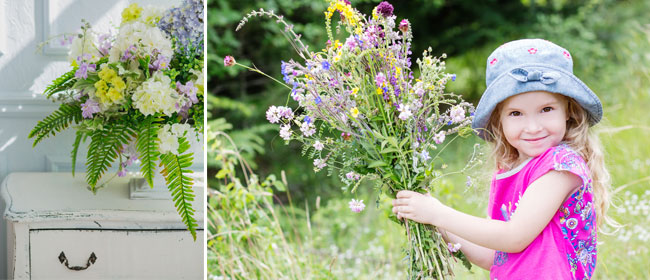Make Life Easy
Last night I gave a talk to the Herald Island Garden Club. I spoke about herbs, but I also talked a little about growing cut flowers.
I have been growing my own cut flowers for several years now, and it really is quite easy to do. Even those with little or no gardening experience can grow their own flowers for picking.
I have a dedicated patch for my cut flowers, but you can also grow your flowers in the vegetable garden, in your garden borders, or in containers.

A beautiful mix of blooms, all of which can be grown in the home garden.
Image from Green Wedding Shoes.
Annuals
Annuals are the mainstay of the cutting garden. Because they bloom so generously, they are ideal for picking – and if you keep picking, the flowers keep coming. Choose varieties whose colours complement or contrast with one another – a soft pink dahlia will enhance the tiny pink blooms of Gypsophila ‘Deep Carmine’, while bold orangey-yellow rudbeckias make a striking contrast to hot red dahlias and purple sweet peas. Think of how you might eventually put your flowers together in a vase and choose plants accordingly.
Easiest annuals to grow for cutting: Cornflower, calendula, dahlia, love-in-a-mist (nigella), scabiosa, snapdragon (antirrhinum), rudbeckia, cosmos, honeywort (cerinthe), sweet pea, aster, zinnia, sunflower, statice (limonium).
Go for long stems
On the whole, choose long-stemmed annuals to make your flower arranging easier – shorter plants may look sweet but are not as suitable for the vase. Select plants labeled “tall” rather than “bedding”. You may have better luck finding taller varieties bred specially for cutting in seed catalogues.

Anything can be used for a vase, including old jugs and kettles. Raid your local thrift store for interesting finds.
Perennials
Unlike annuals, many perennials begin flowering in early spring. So include a few mainstays in your cutting patch, including delphiniums, verbascum, alstroemeria, paeonies (if you live in cooler areas), lilacs (they also like the cold), salvias and viburnum.
Hydrangeas are another great perennial cut flower, with blooms appearing in summer.

Hydrangeas are superb cut flowers, lasting several weeks in the garden and the vase. The flower heads can be dried too.
A mix of shapes
Select a variety of flower forms – tall, spiked flowers such as gladioli and antirrhinum (snapdragons); perfectly rounded blooms such as cosmos, dahlias and zinnias; and some textural plants such as gypsophila and honeywort.
Filler plants
Woody landscape plants are ideal for bulking out floral arrangements. Hydrangeas, lilacs and roses are perfect filler plants, so include these in the mix. Foliage plants are also a must. Foliage introduces structure, shape and balance to arrangements, as well as colour and texture. Try the silver-leafed artemisia, the furry lamb’s ear and fragrant lavender.
The foliage of the evergreen magnolia ‘Little Gem’ lasts forever in a vase – up to a month, and has beautiful glossy green leaves with cinnamon-brown felt-like undersides. It is perfect as a vase filler and its bronze undersides complement many flowers.
Honeywort is another must-have in the cut flower garden, lasting a good 10-14 days in a vase. A hardy annual, its rich purple-blue, tubular flowers are offset by its fleshy blue-green leaves.

Eucalyptus is a great filler for vases and bouquets, especially when paired with white or pale flowers. Foliage can also be spray-painted silver or gold for effect.
Seasonal interest
While many annuals decline after summer, you can extend the flowering period in your cutting patch well into the autumn by planting late-season plants like asters, dahlias, chrysanthemums, rudbeckia and sunflowers. When young, pinch out the tips of sunflowers to encourage early branching, which will produce much bigger yields.
Bulbs
Don’t forget your daffodils, tulips and other spring bulbs, which are planted in autumn. My absolute favourite are anemones and ranunculus, which flower for me in late winter. They are very long-lasting, both in the garden and the vase.
Sowing seeds
Hardy seeds, such as sweet pea and honeywort can be sown directly. The seeds of half-hardy annuals and perennials, which won’t tolerate cold, wet soils, are best sown in trays and planted out when the soil has warmed up and frosts have passed.
Planting
I plant my annuals in my cutting patch fairly closely. In a dedicated cut flower garden you will be picking the flowers continuously, so you can plant closer than you normally would. Make sure the taller, bushier annuals are positioned so they won’t crowd out or shade smaller growing ones. Sweet peas can either be grown up a tepee or a trellis, but place them at the back of the border or where they won’t cast a shadow on flowers planted nearby.
Feeding & Watering
Because annuals use up so much energy trying to produce flowers and seeds in the same season, they need a lot of fertiliser to keep them at their peak flowering. Feed fortnightly with a balanced liquid fertiliser to keep the flowers coming. You’ll need to make sure they are watered well too.
Annuals take more work than perennials, but you get a lot more action (more flowers) out of them if you keep them well fed and watered.
 My Favourites
My Favourites














Speak Your Mind